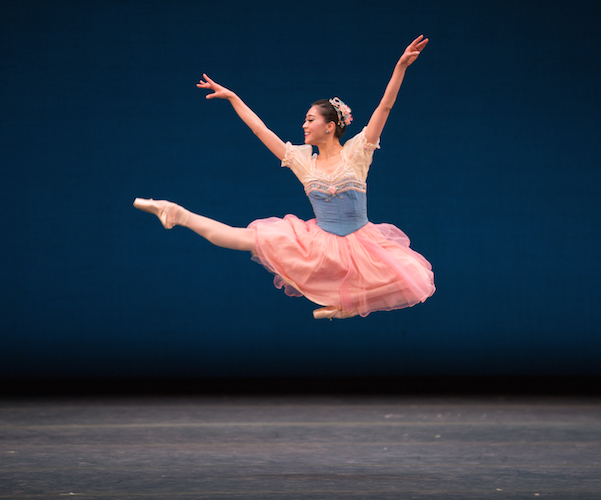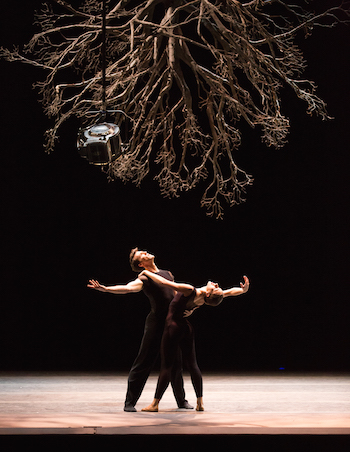Dance Review: Boston Ballet’s “Kylián/ Wings of Wax”
Kylián’s astute choice of musical selections and his recurring use of certain nonliteral themes gave a structural shape to the ballet.
Kylián/ Wings of Wax performed by Boston Ballet, at Boston Opera House, Boston, MA, through April 2.

Misa Kuranaga in George Balanchine’s “Donizetti Variations.” Photo: Rosalie O’Connor, courtesy Boston Ballet
By Marcia B. Siegel
Boston Ballet’s “Wings of Wax” program began its two-week run on Thursday night with dramatic contrasts, George Balanchine’s choreographic miracle Donizetti Variations and Jiří Kylián’s eponymous 1997 work. My appetite for dancing satisfied, I went home after the Kylián. I’d seen Alexander Ekman’s Cacti two years ago, and I didn’t need to experience its pseudo-modern action or its prickly decor another time.
Donizetti Variations, choreographed in 1960 for New York City Ballet’s Melissa Hayden, Jonathan Watts, and a small corps de ballet, was imported to Boston Ballet four years later. Although it was made for a special Salute to Italy in New York, the dance now owes a lot to Balanchine’s illustrious 19th century predecessor August Bournonville. Nancy Reynolds’s invaluable compendium of NYCB works and commentary Repertory in Review (1977) offers photographs of the original cast in puffy Russian tutus; later the costumes were changed to peasantlike skirts and tops that give the ballet a lighter Danish atmosphere. It was always a technical juggernaut, though, and was danced by virtuosos like Violette Verdy and Patricia Wilde in addition to Hayden.
On Thursday night the principal dancers were Misa Kuranaga and Junxiong Zhao, both of whom took the fast, pinpoint footwork and jumps-out-of-nowhere in stride. Kuranaga was especially good at taking small liberties with the timing of a phrase. She could let her arms amplify a step by finishing it slowly with her arms. She could speed up on an exit of turns. Amid the rapid flow of her variation, she added arcane steps to her more obviously difficult, foot-crossing jumps on pointe.
Besides its display of seldom seen classical steps, Donizetti Variations comes with Balanchine’s clever and surprising ensemble work, much of it symmetrical. Those on one side of the stage imitate what the other side has just done; dancers copy one another in close canons; the nine supporting dancers regroup themselves from trios to groups of all-men and all-women.
Balanchine often made steps that played witty musical jokes. Here he inserts a vaudevillean riff. After the principals’ long pas de deux, the ballet seems to be over; then it ramps up again, to a little love song played by an overwrought trumpet. The corps dancers freeze in melodramatic poses and long faces, and one woman takes advantage of the situation by stealing out front and showing some of her best steps, as fast as she can. Just as she’s trying to do Kuranaga’s jumps on pointe, she comes down wrong on one foot and sheepishly limps back into line.
Donizetti Variations has a lightweight reputation among the purist Balanchine critics, but today its modest virtuosity and plotless structure make it fascinating to watch. It was staged for Boston Ballet by Assistant Artistic Director Russell Kaiser. In his days with New York City Ballet, Kaiser was a dependable corps member, and he’s pictured with the Donizetti men’s trio in critic Nancy Goldner’s book of reflections, Balanchine Variations.
Jiří Kylián’s title refers to the myth of Icarus, who tried to escape the earth but flew into the sun, where his homemade wings melted. Wings of Wax had no literal reference to this story that I noticed, but in a rather grandiose program note the choreographer says it represents no less than “our everyday struggles.” It’s a dark ballet. All eight dancers wear black bodywear with bare arms, and soft shoes. A large leafless tree with chopped-off roots hangs upside down over the dancing area, and a lighting instrument continuously circles overhead. The stage is surrounded by black curtains, through which the dancers make shadowy entrances and exits.

Rachele Burlassi and Roddy Doble in Jiří Kylián’s “Wings of Wax.” Photo: Rosalie O’Connor, courtesy Boston Ballet.
At first you might take this to be just another of those endlessly inventive, rambling modern ballets, but Kylián’s astute choice of musical selections and his recurring use of certain nonliteral themes gave a structural shape to the ballet. So you’re left with more than luscious movement to admire. [An excellent video by its originating company, Netherlands Dance Theater, in 2008, is here.]
The piece starts with a Passacaglia, the 17th century’s precursor of minimalism, by Heinrich von Biber. As the solo violin repeats its four-note descending theme with variations, the four couples emerge one at a time, roughly overlapping as the music goes into new variations. Kathleen Breen Combes and Paul Craig are succeeded by Rachele Buriassi and Roddy Doble, Lia Cirio and John Lam, and Ashley Ellis and Lawrence Rines. With arms flung out, they swoop and slide, using a deep plié and a deeply rhythmic sense of continuity that’s intensified by strategic full stops. The body stretches and bends rather than maintaining a balletic verticality. There’s not much subtlety in this big demonstrative movement, but the dancers respond to little embellishments in the music with fluttering hands, feet, or heads.
After the Biber, there’s a short interlude for prepared piano by John Cage. As the music plinks and thuds in a couple of pages of notes and silences, the four women come forward in slow motion, anatomizing the walking steps and stopping at intervals, so that we see every shift of thigh, shoulder and arm by itself.
Later, to the third movement of Philip Glass’s String Quartet No. 5, the men appear and one by one, weave through the static locomoting of the women. Glass pits his typical syncopated chords over a jittery repetitive bass line, and the men rush into big sideways jumps and turns. Finally the Glass melts into a string trio version of No. 25 from J.S.Bach’s Goldberg Variations. The couples return, reflecting the somber tone of the music without acting it. Their connections seem to grow closer, the lifts more extreme, and the music gets even slower. Ellis and Rines embrace and lean out and embrace, again and again in a fading light, as the music subsides on a quiet two-note cadence.
Internationally known writer, lecturer, and teacher Marcia B. Siegel covered dance for 16 years at The Boston Phoenix. She is a contributing editor for The Hudson Review. The fourth collection of Siegel’s reviews and essays, Mirrors and Scrims—The Life and Afterlife of Ballet, won the 2010 Selma Jeanne Cohen prize from the American Society for Aesthetics. Her other books include studies of Twyla Tharp, Doris Humphrey, and American choreography. From 1983 to 1996, Siegel was a member of the resident faculty of the Department of Performance Studies, Tisch School of the Arts, New York University.
Tagged: Boston-Ballet, Donizetti Variations, George Balanchine, Kylián/ Wings of Wax
